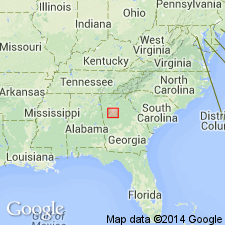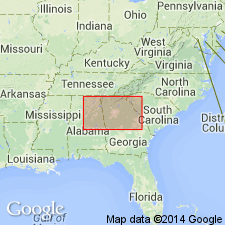
- Usage in publication:
-
- Camp Creek Formation*
- Modifications:
-
- Named
- Dominant lithology:
-
- Gneiss
- Amphibolite
- AAPG geologic province:
-
- Piedmont-Blue Ridge province
Summary:
The Camp Creek Formation is here named the youngest unit of the Atlanta Group in the Newnan-Tucker synform near Atlanta, GA. It consists of massive granite gneisses interlayered with thin fine-grained, dark green hornblende-plagioclase amphibolites. Gradationally overlies the Big Cotton Indian Formation; its contacts with other units are sharp and conformable. Intruded by Union City Complex and Palmetto Granite. Thickness is 600 to 3,000 m. Age is Late Proterozoic and (or) early Paleozoic.
Source: GNU records (USGS DDS-6; Reston GNULEX).

- Usage in publication:
-
- Camp Creek Formation†
- Modifications:
-
- Abandoned
- AAPG geologic province:
-
- Piedmont-Blue Ridge province
Summary:
The Camp Creek Formation is here abandoned because it is now known to be part of the [†]Promised Land Formation in the Promised Land thrust sheet. [Promised Land now Lithonia Gneiss.]
Source: GNU records (USGS DDS-6; Reston GNULEX).
For more information, please contact Nancy Stamm, Geologic Names Committee Secretary.
Asterisk (*) indicates published by U.S. Geological Survey authors.
"No current usage" (†) implies that a name has been abandoned or has fallen into disuse. Former usage and, if known, replacement name given in parentheses ( ).
Slash (/) indicates name conflicts with nomenclatural guidelines (CSN, 1933; ACSN, 1961, 1970; NACSN, 1983, 2005, 2021). May be explained within brackets ([ ]).

